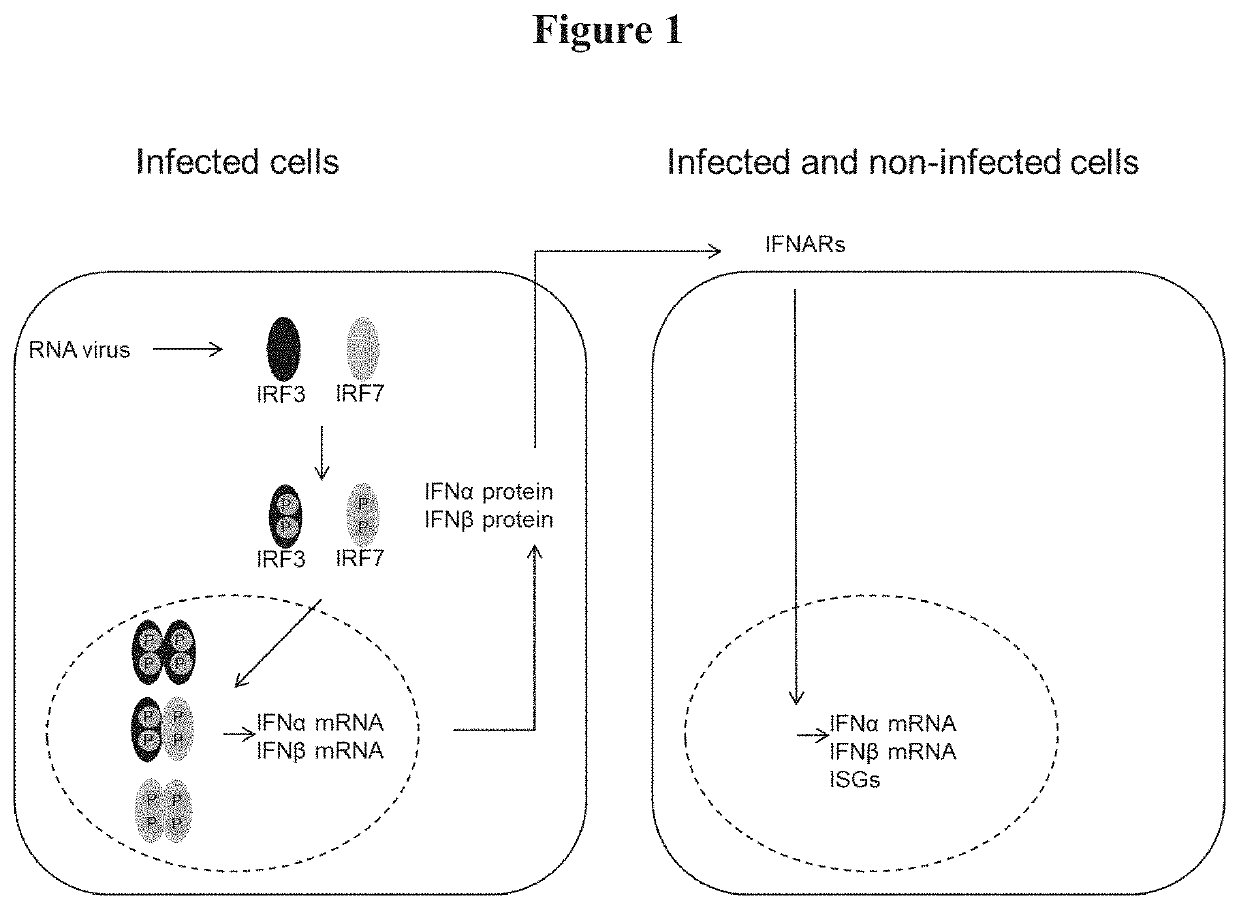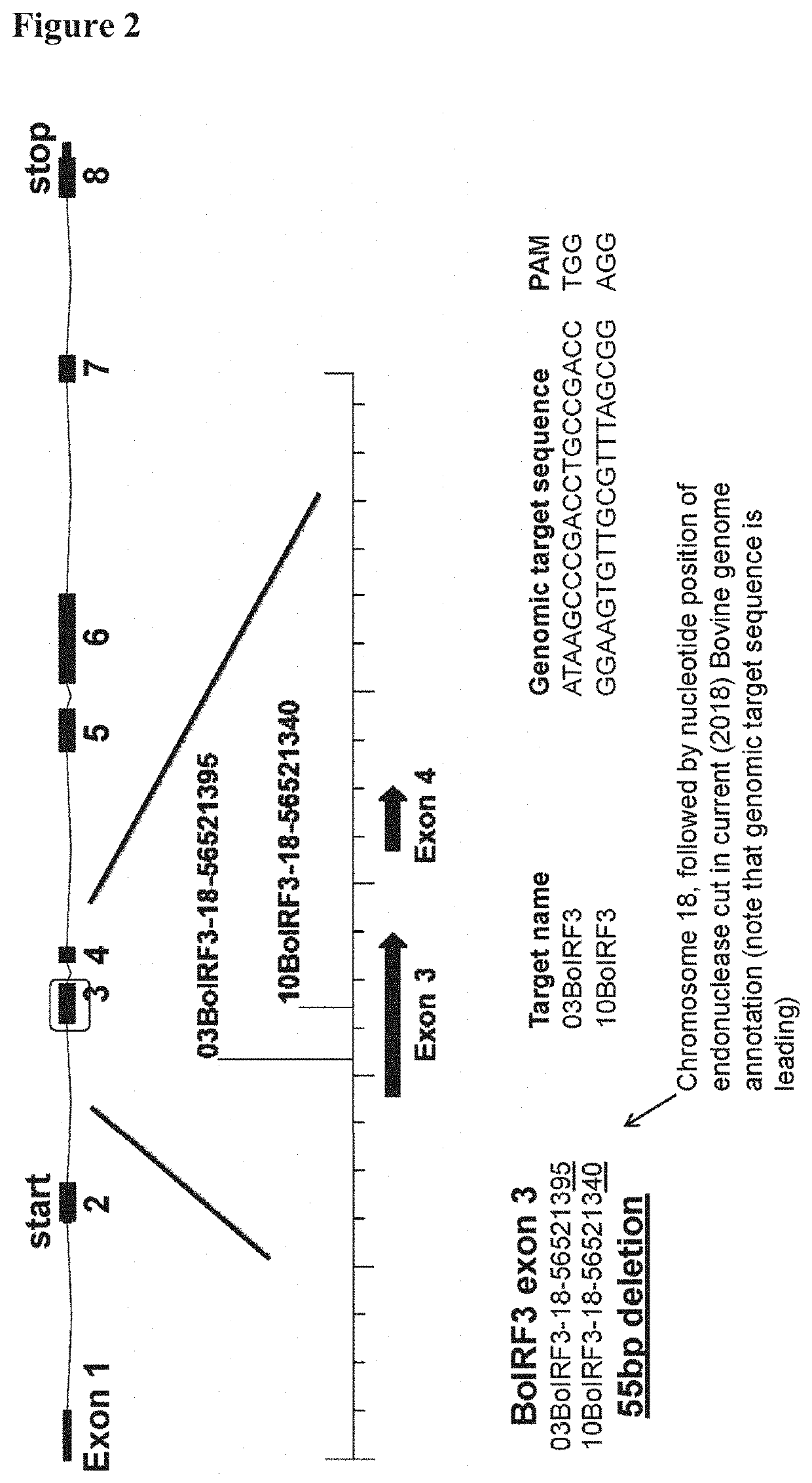Mdbk irf3/irf7 knock out mutant cell and its use for vaccine production
a technology of mutant cells and vaccines, applied in the field of mdbk irf3/irf7 knockout mutant cells and their use for vaccine production, can solve the problems of reducing the severity of disease, huge economic loss, and current vaccine production systems using mammalian cell culture only give limited yields, so as to increase viral yield and stably and permanently inactivate the innate immune system
- Summary
- Abstract
- Description
- Claims
- Application Information
AI Technical Summary
Benefits of technology
Problems solved by technology
Method used
Image
Examples
example 1
[0121]Preparation of MDBK ΔIRF3 / IRF7 double knock out mutant cells (designated as MDBK cell clones #1 and #2) using CRISPR / Cas9
[0122]MDBK cell clones #1 and #2 are clonal cell lines derived from MDBK 42 / E9 (CCT103). In each of the clones, both genomic copies of the IRF3 gene and both genomic copies of the IRF7 gene have been functionally inactivated using CRISPR / Cas9 mediated genome editing.
[0123]Parental cell line MDBK 42 / E9 was cultured in animal component free (ACF) culture medium (T. Johnson, Sigma-Aldrich Corporation, St. Louis, Mo., USA: Serum-Free Systems for MDBK and MDCK Epithelial Cells.)+0.1% Poloxamer 188 and passaged using cell dissociation reagent TrypLE (Animal component-free, recombinant trypsin that replaces porcine trypsin) in PBS+0.01% EDTA. Cells were cultured in adherent conditions in Corning Biocoat collagen I culture flasks. Cells were cultured at 38° C. and 5% CO2 in a humidified incubator.
[0124]The Cas9 / RNA complexes were prepared as described in the Alt-R C...
example 2
[0128]Testing of functionality of the Interferon type 1 signaling pathway in MDBK CCT094, MDBK 42 / E9, MDBK #1 and MDBK #2 cell lines
TABLE 2Overview of MDBK cell lines used in the experiments:MDBK CCT094Current BRSV production cell line(Marburg)MDBK 42 / E9MDBK 42 obtained by Intervet International BV from the University ofHannover in 1990. MDBK 42 / E9 is a single cell clone selected based on optimalgrowth of Bovine coronavirusMDBK #1MDBK 42 / E9 with AIRF3 / IRF7 as described in this applicationMDBK #2MDBK 42 / E9 with AIRF3 / IRF7 as described in this application
[0129]Experiment 1
[0130]This experiment was set up to measure relative gene expression levels of ISGs (Interferon-stimulated genes) 24 hrs after Poly (I:C) transfection. This experimentally addresses functionality of the first phase of the innate immune response after pathogen recognition by TLRs in virus infected cells (see FIG. 1). Poly (I:C) is synthetic dsRNA that mimics viral RNA infection.
[0131]Cell lines tested:[0132]MDBK CCT09...
example 3
[0180]Production of BRSVJencine in ΔIRF3 / IRF7 mutant cell lines MDBK #1 and MDBK #2 and parental cell line MDBK 42 / E9 in shaker flasks
[0181]Single cell clones of MDBK #1 and MDBK #2 and parental cell line MDBK 42 / E9 were expanded in adherent culture conditions in roller bottles. Cells were cultured in animal component free (ACF) culture medium (T. Johnson, Sigma-Aldrich Corporation, St. Louis, Mo., USA: Serum-Free Systems for MDBK and MDCK Epithelial Cells.)+0.1% Poloxamer 188 and passaged using cell dissociation reagent TrypLE (Animal component-free, recombinant trypsin that replaces porcine trypsin, ThermoFisher) in PBS+0.01% EDTA. Roller bottles were coated with Intervet Coat I (Recombinant Human Collagen Type 1; 0.25 μg / cm2).
[0182]Subsequently, cells were passaged in ACF culture medium in shaker flasks. For this purpose, 250 ml shaker flasks with 125 ml culture medium were used, with cell densities between 0.5*106 cells / mL to 1*106 cells / mL. The culture was incubated at 37° C. a...
PUM
 Login to View More
Login to View More Abstract
Description
Claims
Application Information
 Login to View More
Login to View More - R&D
- Intellectual Property
- Life Sciences
- Materials
- Tech Scout
- Unparalleled Data Quality
- Higher Quality Content
- 60% Fewer Hallucinations
Browse by: Latest US Patents, China's latest patents, Technical Efficacy Thesaurus, Application Domain, Technology Topic, Popular Technical Reports.
© 2025 PatSnap. All rights reserved.Legal|Privacy policy|Modern Slavery Act Transparency Statement|Sitemap|About US| Contact US: help@patsnap.com



